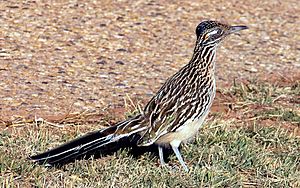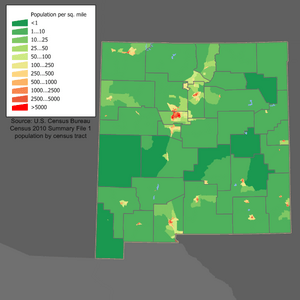Geography of New Mexico facts for kids
New Mexico is a large state in the southwestern United States. It's the fifth-largest state, covering about 314,900 square kilometers (121,590 square miles). To its east are Oklahoma and Texas. To the south, it borders Texas and the Mexican states of Chihuahua and Sonora. On its west is Arizona, and to the north is Colorado. New Mexico, Colorado, Arizona, and Utah meet at a special spot called the Four Corners.
Even though many people think New Mexico is just a dry desert, it has many different kinds of landscapes! You can find wide, reddish deserts, green grasslands, flat-topped mesas, and tall, snowy mountains. About a third of the state is covered in forests, especially in the north. The Sangre de Cristo Mountains, which are part of the Rocky Mountains, run through the northern part of the state. The Great Plains stretch into the eastern part, including a flat area called the Llano Estacado. In the northwest, you'll find the Colorado Plateau with its unique volcanic shapes and dry lands. The huge Chihuahuan Desert covers the southern part of New Mexico.
Most of New Mexico is high up, more than 1,200 meters (4,000 feet) above sea level. The highest point is Wheeler Peak in the Sangre de Cristo Mountains, which is over 4,011 meters (13,160 feet) tall! The lowest point is the Red Bluff Reservoir, at about 866 meters (2,840 feet).
New Mexico has five main rivers. The most important is the Rio Grande, which flows almost through the middle of the state from north to south. Its rich floodplains have been home to people for a very long time. Other major rivers include the Pecos, Canadian, San Juan, and Gila. Most of these rivers have dams that help with irrigation for farms and control floods. Besides rivers, New Mexico doesn't have many large natural lakes. But it does have several man-made lakes and reservoirs, like Elephant Butte Reservoir, which was once the biggest man-made lake in the world!
Climate
New Mexico is known for its dry and mild weather. Most of the state has a semi-arid climate, meaning it's quite dry. Higher up in the mountains, the climate can be continental or even alpine, with colder temperatures.
On average, New Mexico gets about 348 millimeters (13.7 inches) of rain each year. Most of the rain falls in the summer, especially in the north-central area around Albuquerque and in the south. The eastern part of the state usually gets the most rain, while the western part gets the least. High mountain areas can get around 1,000 millimeters (40 inches) of rain, but the lowest places might only get 200 to 250 millimeters (8 to 10 inches).
Temperatures across the state can vary a lot. The average temperature is around 12°C (mid-50s °F). In the southeast, the average can be 18°C (65°F), while in the northern mountains, it can be below 4°C (40°F). In summer, daytime temperatures can often go above 38°C (100°F) in lower areas. The highest temperature ever recorded in New Mexico was 50°C (122°F) near Loving in 1994. In winter, from November to March, many cities can have very cold nights, sometimes below -10°C (10°F). The lowest temperature ever recorded was -46°C (-50°F) in Gavilan in 1951.
Because New Mexico has clear skies and not many people, there's less light pollution. This makes it a great place for looking at the stars! That's why several big astronomical observatories, like the Very Large Array, are located here.
Flora and Fauna

New Mexico's different landscapes create six special areas for plants and animals. The largest area is the Upper Sonoran Zone, which covers about three-fourths of the state. Here, you'll find prairie grasses, small pinyon pine trees, and juniper bushes. The Llano Estacado in the east has short grasses that feed bison. The Chihuahuan Desert in the south is known for its shrubby creosote plants. In the northwest, the Colorado Plateau is a high desert with cold winters, where you can see sagebrush and other plants that like salty soil.
The mountains in the north have many types of plants depending on how high up you go. You'll find pine and juniper trees at the bottom, then evergreen conifers, spruce-fir, and aspen forests higher up. At the very top, there's alpine tundra, where only small, tough plants can grow. The southwestern part of the state, called the Apachian zone, has special oak woodlands and Arizona cypress trees that aren't found elsewhere in New Mexico. The southern parts of the Rio Grande and Pecos valleys have excellent land for grazing animals and farming.
New Mexico's varied climate and plant life mean it has many different kinds of wildlife. You can find black bears, bighorn sheep, bobcats, cougars, deer, and elk in the mountains. In the lower areas, there are coyotes, jackrabbits, kangaroo rats, javelina, porcupines, pronghorn antelope, and wild turkeys. The famous roadrunner, which is the state bird, is common in the southeast. Some animals, like the Mexican gray wolf and the Rio Grande silvery minnow, are endangered, and people are working to protect them. More than 500 types of birds live in or travel through New Mexico, which is a lot!
Conservation
New Mexico is a leader in protecting its natural spaces. About one-third of the state's land is owned by the U.S. government, which is a very high percentage. Much of this land is managed by the Bureau of Land Management and the U.S. Forest Service.
New Mexico played a big part in the early 1900s conservation movement. The Gila Wilderness was even named the world's first wilderness area in 1924! The state also has many national monuments, like El Morro, created in 1906, and the Gila Cliff Dwellings, from 1907. These places protect important natural and historical sites.
New Mexico has several National Forests and areas managed by the National Park Service, including:
- Carlsbad Caverns National Park, famous for its amazing caves.
- White Sands National Park, known for its beautiful white gypsum dunes.
- Aztec Ruins National Monument
- Bandelier National Monument
- Chaco Culture National Historical Park
- Petroglyph National Monument
- Rio Grande del Norte National Monument
- Valles Caldera National Preserve
There are also many National Wildlife Refuges in New Mexico, like Bitter Lake National Wildlife Refuge and Bosque del Apache National Wildlife Refuge. These refuges help protect different kinds of animals and their homes. The state also has many State Parks, offering places for people to enjoy nature and outdoor activities.
Environmental Issues
New Mexico faces some environmental challenges. In 2016, the state sued the United States Environmental Protection Agency because of a big spill from the Gold King Mine. This spill released harmful metals and toxins into the Animas River, polluting water in several states. Since then, New Mexico has been working on stronger rules to prevent pollution from resource extraction.
The state is also a big producer of greenhouse gases, mostly from its oil and gas industry. These gases contribute to climate change. The New Mexico government is trying to fix this by making rules for industrial emissions, encouraging renewable energy sources like solar and wind power, and making it easier for people to use electric vehicles.
Settlements
New Mexico is one of the least crowded states in the U.S., with only about 7 people per square kilometer (17 people per square mile). The U.S. average is much higher, around 35 people per square kilometer (90 people per square mile). The state is divided into 33 counties and has 106 cities, towns, and villages.
Most people in New Mexico live in the north-central part of the state, especially around Albuquerque, which is the largest city. The Albuquerque area, including Rio Rancho, has over 918,000 people, which is about one-third of everyone in New Mexico. Nearby is Santa Fe, the state capital and fourth-largest city. If you combine the areas around Albuquerque, Santa Fe, and Las Vegas, you get almost 60% of the state's population!
Another major population center is in the south-central area around Las Cruces, the second-largest city. The Las Cruces area has about 214,000 residents. When combined with nearby El Paso, Texas, this larger area has over 1 million people.
New Mexico is also home to 23 Native American tribal reservations, including part of the Navajo Nation, which is the largest tribe. Most of these tribes are in the northwest and north-central parts of the state.
| Rank | Name | Pop. |
|---|---|---|
| 1 | Albuquerque | 558,545 |
| 2 | Las Cruces | 101,712 |
| 3 | Rio Rancho | 96,159 |
| 4 | Santa Fe | 83,776 |
| 5 | Roswell | 47,775 |
| 6 | Farmington | 45,450 |
| 7 | Clovis | 38,962 |
| 8 | Hobbs | 37,764 |
| 9 | Alamogordo | 31,248 |
| 10 | Carlsbad | 28,774 |
Images for kids










